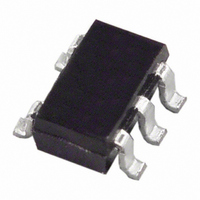AD8601ART-REEL7 Analog Devices Inc, AD8601ART-REEL7 Datasheet - Page 16

AD8601ART-REEL7
Manufacturer Part Number
AD8601ART-REEL7
Description
IC OPAMP GP CMOS 8.4MHZ SOT23-5
Manufacturer
Analog Devices Inc
Series
DigiTrim®r
Datasheet
1.AD8601ARTZ-REEL7.pdf
(24 pages)
Specifications of AD8601ART-REEL7
Design Resources
Fully Isolated Input Module Based on AD7793, ADuM5401, and a High Performance In-Amp (CN0067)
Amplifier Type
General Purpose
Number Of Circuits
1
Output Type
Rail-to-Rail
Slew Rate
6 V/µs
Gain Bandwidth Product
8.4MHz
Current - Input Bias
0.2pA
Voltage - Input Offset
80µV
Current - Supply
750µA
Current - Output / Channel
50mA
Voltage - Supply, Single/dual (±)
2.7 V ~ 5.5 V
Operating Temperature
-40°C ~ 125°C
Mounting Type
Surface Mount
Package / Case
SOT-23-5, SC-74A, SOT-25
Lead Free Status / RoHS Status
Contains lead / RoHS non-compliant
-3db Bandwidth
-
Other names
AD8601ART-REEL7
AD8601ART-REEL7TR
AD8601ART-REEL7TR
Available stocks
Company
Part Number
Manufacturer
Quantity
Price
Company:
Part Number:
AD8601ART-REEL7
Manufacturer:
AD
Quantity:
6 785
Company:
Part Number:
AD8601ART-REEL7
Manufacturer:
INFINEON
Quantity:
6 786
AD8601/AD8602/AD8604
INPUT OVERVOLTAGE PROTECTION
As with any semiconductor device, if a condition could exist
that could cause the input voltage to exceed the power supply,
the device’s input overvoltage characteristic must be considered.
Excess input voltage energizes the internal PN junctions in the
AD860x, allowing current to flow from the input to the supplies.
This input current does not damage the amplifier, provided it is
limited to 5 mA or less. This can be ensured by placing a resistor in
series with the input. For example, if the input voltage could
exceed the supply by 5 V, the series resistor should be at least
(5 V/5 mA) = 1 kΩ. With the input voltage within the supply
rails, a minimal amount of current is drawn into the inputs,
which, in turn, causes a negligible voltage drop across the series
resistor. Therefore, adding the series resistor does not adversely
affect circuit performance.
OVERDRIVE RECOVERY
Overdrive recovery is defined as the time it takes the output of
an amplifier to come off the supply rail when recovering from
an overload signal. This is tested by placing the amplifier in a
closed-loop gain of 10 with an input square wave of 2 V p-p
while the amplifier is powered from either 5 V or 3 V.
The AD860x has excellent recovery time from overload conditions.
The output recovers from the positive supply rail within 200 ns
at all supply voltages. Recovery from the negative rail is within
500 ns at a 5 V supply, decreasing to within 350 ns when the
device is powered from 2.7 V.
POWER-ON TIME
The power-on time is important in portable applications where
the supply voltage to the amplifier may be toggled to shut down
the device to improve battery life. Fast power-up behavior ensures
that the output of the amplifier quickly settles to its final voltage,
improving the power-up speed of the entire system. When the
supply voltage reaches a minimum of 2.5 V, the AD860x settles to
a valid output within 1 μs. This turn-on response time is faster
than many other precision amplifiers, which can take tens or
hundreds of microseconds for their outputs to settle.
USING THE AD8602 IN HIGH SOURCE IMPEDANCE
APPLICATIONS
The CMOS rail-to-rail input structure of the AD860x allows
these amplifiers to have very low input bias currents, typically
0.2 pA. This allows the AD860x to be used in any application
that has a high source impedance or must use large value
resistances around the amplifier. For example, the photodiode
amplifier circuit shown in Figure 56 requires a low input bias
current op amp to reduce output voltage error. The AD8601
minimizes offset errors due to its low input bias current and low
offset voltage.
Rev. G | Page 16 of 24
The current through the photodiode is proportional to the incident
light power on its surface. The 4.7 MΩ resistor converts this current
into a voltage, with the output of the AD8601 increasing at 4.7 V/μA.
The feedback capacitor reduces excess noise at higher frequencies
by limiting the bandwidth of the circuit to
Using a 10 pF feedback capacitor limits the bandwidth to
approximately 3.3 kHz.
HIGH SIDE AND LOW SIDE, PRECISION CURRENT
MONITORING
Because of its low input bias current and low offset voltage, the
AD860x can be used for precision current monitoring. The true
rail-to-rail input feature of the AD860x allows the amplifier to
monitor current on either the high side or the low side. Using both
amplifiers in an AD8602 provides a simple method for monitoring
both current supply and return paths for load or fault detection.
Figure 57 and Figure 58 demonstrate both circuits.
BW
MONITOR
=
MONITOR
OUTPUT
OUTPUT
2
π
(
2N3904
4
3V
D1
Figure 56. Amplifier Photodiode Circuit
7 .
100Ω
Figure 58. High-Side Current Monitor
Figure 57. Low-Side Current Monitor
2N3905
Q1
R1
1
M
100Ω
3V
Ω
R1
Q1
R2
249kΩ
R
)
(OPTIONAL)
SENSE
0.1Ω
C
R2
2.49kΩ
4.7MΩ
F
R
10pF
SENSE
0.1Ω
AD8601
3V
1/2 AD8602
3V
1/2 AD8602
I
L
V
4.7V/µA
OUT
RETURN TO
GROUND
V+
(1)















